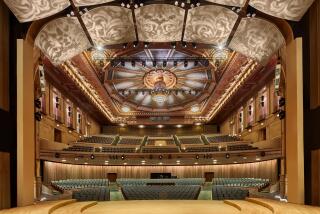A heart-to-heart with Mr. Mahler
- Share via
Mahler’s Ninth Symphony begins with what must be the most tender tolling in all music. The cellos intone a low A, long and short. A horn quietly echoes its acknowledgment. A harp rings “goodbye” in harp-speak. The violas flutter angelically. A melody arises from the second violins so sweetly satisfying that it hardly seems to have come from this world.
Death has, on placid cat paws, entered the room.
We, the listeners to this wondrous symphony, which Mahler wrote in 1907 just after he was diagnosed with his fatal heart disease, are now in the Grim Reaper’s thrall. And we expect from a conductor spiritual guidance to get us through the next 90 or so minutes, a guru to illuminate the fragility of life. Music has nothing more important to say than this, and nothing less from its practitioners will do.
But when Michael Tilson Thomas conducted the Ninth with his San Francisco Symphony at Walt Disney Concert Hall on Wednesday, he did something disarmingly irregular. I have always heard this symphony as Mahler’s persuasive psychic road map to ... well, that’s just the point; I don’t know where.
But in Tilson Thomas’ exceptionally vivid performance, the symphony was no longer about me, or any of us in Disney Hall, but about Mahler.
Instead of attempting to channel Mahler for his listeners, Tilson Thomas challenged the composer.
Look, Gustav, Tilson Thomas might have been saying, this wistful early 20th century leave-taking is all well and good, as is the looking back with fond nostalgia, the Romantic dreaming of unimaginable vistas and all the rest. But who were you really? Don’t we need to know that if we are going to take you with us into the next century?
And so the first movement, the slow, sweeping lyricism that rises and falls like the labored but precious breath of a dying man, became downright contentious. Conducting with tough love, Tilson Thomas cut the morphine drip, refusing the patient anything that would limit his feeling or keep him from confronting his inner demons.
Some of the harshness of highs and the overblown climaxes in this movement were probably a result of the San Francisco Symphony adapting to Disney’s no-place-to-hide acoustics. This has become a fine and uncommonly expressive Mahler orchestra under Tilson Thomas as its live Mahler recordings prove. But at first the orchestra sounded constricted and pushed just a touch too hard.
Things improved as the symphony progressed.
The hallmark of Tilson Thomas’ Mahler is the unique space he creates for his players to be individuals within the collective. This was especially notable in the middle of the symphony where Mahler looks back on his life, first in a nostalgic landler-like movement, then with a raucous reenactment of his hurly-burly life in what he called a Rondo-Burleske.
It is easy to conduct this movement as one last Mahlerian wild ride, the composer’s ultimate been-there-and-done-that moment before moving on. But here Tilson Thomas asked his most probing, who-were-you-really questions of Mahler. He had no intention of letting Mahler forget that although he held the highest seat of musical power in Vienna, he was a provincial Jew from Bohemia who converted to Catholicism. The woodwinds burst into a kind of coverup klezmer to reveal Mahler’s true roots.
With the defenses down, Tilson Thomas then engaged Mahler in an amazing conversation. By allowing such freedom of his players (by trusting them with such freedom), he revealed how close Mahler was to the collage style of Ives’ music. Mahler was not just saying goodbye, and maybe he wasn’t saying goodbye at all. He was breaking new ground.
The last movement is, of course, the supposed otherworldly finale not just to the Ninth but to life (although Mahler did live on long enough to write most of a Tenth Symphony). Tilson Thomas, however, was not teary-eyed. He presented us with a Mahler who could create a clotted string effect at one point that sounded vital and modern, a Mahler whose stillness was that not of sentimental leave-taking but closer to the stunning, sublime, late 20th century silences of Morton Feldman. Right up to the very end, as the movement dies away into transcendental nothingness, Tilson Thomas meant this to be music engaged with the present.
The audience, Wednesday, went wild.
More to Read
The biggest entertainment stories
Get our big stories about Hollywood, film, television, music, arts, culture and more right in your inbox as soon as they publish.
You may occasionally receive promotional content from the Los Angeles Times.











